
Overland Telegraph Line EmployeesPrint Page 
The monument commemorates employees of the Overland Telegraph Line who were killed or injured during incidents with Aborigines at Barrow Creek in February 1874 and Roper River in June 1875.
AN ASSOCIATED PRESS TELEGRAM.
Adelaide, Tuesday evening.
Mr Randell the acting station master at Daly Waters, has reported that Mr C. H. Johnston, the station master, had been speared by the natives at Roper river, on June 20th, and had died from the effects of his wounds on the following day. Two men who were in his employ, Daer and Richards had also been speared, but were getting better. It appears that Mr Johnston and the two men had left Daly Waters to search for strayed horses and cattle on the Roper, when they were attacked as described.
Geelong Advertiser (Vic), 14 July 1875.
A monument (says the Register) has recently been erected in the West-terrace Cemetery to Messrs. Stapleton, Frank, Johnston, and Daer, who were speared by blacks in the Northern Territory. It consists of a fluted column of Caen stone, having the top broken off, and a wreath of flowers, cut in the same kind of stone, encircling it, and its height is nearly 12ft.,of which the column measures about 6ft. It rests on a square base, supported on two broader bases, all of Caen stone. On each side of the upper base a slab of beautifully veined Italian marble is let in. That facing the north is plain, that on the eastside bears the inscription, " James Lorenzo Stapleton, Stationmaster, Barrow's Creek, speared February 22, 1874 ; died February 23,1874, aged 40, John Frank, speared at Barrow's Creek, February 22, 1874; died the same day." On the south side, facing the main walk, the following is cut in the marble slab, like the other inscriptions, with gilt letters :—" This monument is erected by the officers and men on the Overland Telegraph Line, in memory of their comrades who were treacherously murdered by the blacks while in the discharge of their duties." On the west tablet is cut:—Chas. Henry Johnston, Stationmaster, Daly Waters, speared at the Roper River, June 29, 1875; died June 30, 1875, aged 28. Abram Daer, speared at the Roper River, June 29, 1875 ; died August 7, 1875, aged 40.
A low railing of ornamental ironwork surrounds the whole. Mr. E. H. Herring, of Waymouth-street, constructed the monument,which is of excellent workmanship. The site was selected by Mr. Brooks, the curator of the cemetery, and could not have been better chosen, as the memorial is the first object of the kind seen from the entrance gate, and is placed as near as it conveniently could be to the main walk. We are informed that Mr. Stapleton's name was incorrectly given to Mr. Herring,and that he has had orders to correct it to James Oliver Lawrence Stapleton.
Albury Banner and Wodonga Express (NSW), 30 September 1876.
Location
| Address: | West Terrace, West Terrace Cemetery, Adelaide, 5000 |
|---|---|
| State: | SA |
| Area: | AUS |
| GPS Coordinates: | Lat: -34.933545 Long: -34.933545 Note: GPS Coordinates are approximate. |
Details
| Monument Type: | Monument |
|---|---|
| Monument Theme: | Conflict |
| Sub-Theme: | Frontier |
| Approx. Event Start Date: | February-1874 |
| Approx. Event End Date: | June-1875 |
Dedication
| Approx. Monument Dedication Date: | September-1876 |
|---|
This monument is erected by the Officers and men of the Overland Telegraph Line
In memory of their comrades who were treacherously murdered by the blacks whilst in the discharge of their duty :
Charles Henry Johnston,
Station Master, Daly Waters,
Speared at the Roper River,
29. June, 1875,
Died 30. June, 1875, aged 28.
Abram Dauer,
Speared at the Roper River,
29. June, 1875,
Died 7. Augt, 1875, aged 40.
In memory of Ernest E. S. Flint J. P.
Senior and Inspecting Officer of the Southern Section of the Overland Telegraph Line.
One of the survivors of the attack by natives of the Barrow Creek Station, 24 Feb. 1874. In which he was wounded.
He died after a short iIlness at Alice Springs,
17 July 1887. Aged 33 years.
His memory will remain green in the hearts of those with whom he has been long associated.
James Lorenzo Stapleton,
Station Master, Barrow`s Creek,
Speared February, 22. 1874,
Died 23. February. 1874,
Aged 40.
John Frank,
Speared at Barrow`s Creek,
22. February, 1874,
Died the same day.
Plaque :
The Overland Telegraph
Connecting Australia with the world
The telegraph was the communications revolution of the mid 19th century. Messages that once took months to travel over land and sea could now be transmitted by telegraph in a matter of hours.
Building the trans-continental telegraph also offered an opportunity to open up Australia`s interior: allowing further settlement, expansion of agriculture, and the exploitation of mineral resources. There was fierce competition between the colonies to secure a route for the telegraph and reap the benefits that would flow from it.
South Australia secured its position by sponsoring John McDouall Stuart`s cross-continental expedition and annexing the Northern Territory in 1863. The chosen route for the telegraph, mapped by explorer John Ross, closely follwed Stuart`s path - linking Adelaide to Darwin and from there via a submarine cable to the rest of the world. The construction of the 3,200 km line to a mere 18 months. This epic feat was one of the greatest engineering achievements of the era. The first official message was transmitted on 22 August 1872.
Tragedies along the telegraph line
A turning point in colonist - Indigenous relations
This monument commemorates the lives of telegraph workers killed and injured during incidents at Barrow Creek in February 1874 and Roper River in June 1875. The wording of the memorial says a lot about colonists` attitude to Indigenous people at the time.
When explorers first passed through Australia`s centre, they reported friendly interactions with Aboriginal groups, but these were only fleeting encounters. Relations became more complex when the telegraph line indicated a more permanent European presence. The two cultures often misunderstood each other, leading to mutual mistrust that sometimes escalated in violent attacks and reprisals.
The Barrow Creek attack was the first such incident at a telegraph station. The ability to transmit events as they unfolded , including the dying James Stapleton tapping out a farewell message to his distraught wife, created a sensation at the time. Written history only reports the European perspective of these skirmishes, so we cannot know for sure exactly what chain of events culminated in the incidents memorialised by this monument.


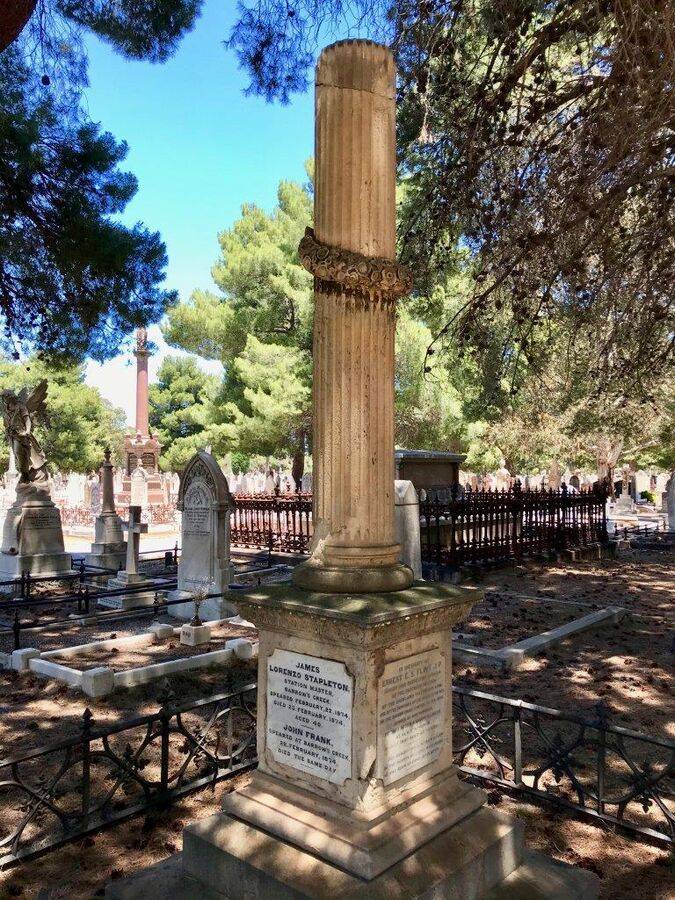

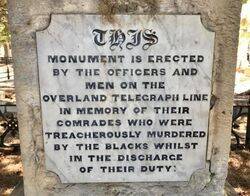
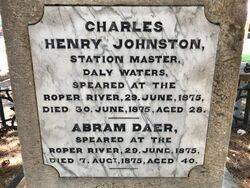
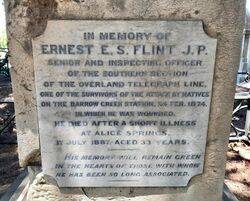
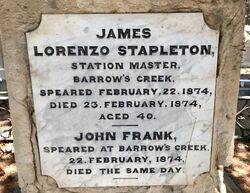
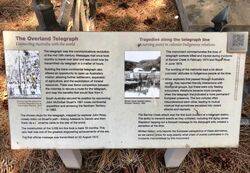
 Barrow Creek Attack 1875
Barrow Creek Attack 1875
